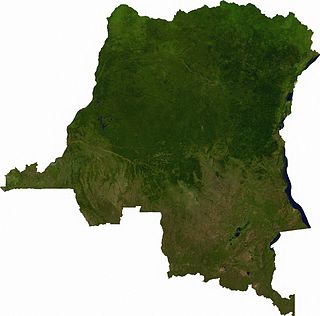
The Lualaba River flows entirely within the eastern Democratic Republic of the Congo. It is the greatest river source (headstream) of the Congo River by volume of water. The Lualaba is 1,800 kilometres (1,100 mi) long. Its headwaters are in the country's far southeastern corner near Musofi and Lubumbashi in Katanga Province, next to Zambia. The Chambeshi River is the longest river source (headstream) of the Congo.

Kisangani is the capital of Tshopo province in the Democratic Republic of the Congo. It is the fifth most populous urban area in the country, with an estimated population of 1,261,000 in 2020, and the largest of the cities that lie in the tropical woodlands of the Congo.

The Lomami River is a major tributary of the Congo River in the Democratic Republic of the Congo. The river is approximately 1,280 km (800 mi) long. It flows north, west of and parallel to the upper Congo.

Articles related to the Democratic Republic of the Congo include:

Isangi is a territory of the Democratic Republic of the Congo. It is located in the Tshopo District to the west of Kisangani, and mostly to the south of the Congo River. The largest community is Yangambi. Other communities are Isangi, Ligasa and Yanonge. The village of Yaboila was the scene of the murder in 1905 by Topoke people of two white officers of the Lomami Company, which led to severe reprisals.
Paul Lomami-Tshibamba was a Congolese journalist and author, acclaimed as "the first giant of Congolese literature".
The Mbole people are an ethnic group of about 150,000 people living in the Orientale Province, southwest of Kisangani in the Democratic Republic of the Congo. The Mbole were previously referred to as Bambole.

Ilambi is a community in the Tshopo Province of the Democratic Republic of the Congo, on the Lomami River. It is 20 kilometres (12 mi) to the south of the point where the Lomani enters the Congo River. Most of the inhabitants are Topoke people.
The Poke language, is in the Soko–Kele languages group of Bantu languages. It is spoken by the Topoke people of the Tshopo District, Isangi Territory, in the Democratic Republic of the Congo.

Yaboila is a village in the Isangi Territory of the Democratic Republic of the Congo.
The Baboa people are an ethnic group in the Democratic Republic of the Congo. They speak the Bwa language.
The Turumbu people live in the Democratic Republic of the Congo, mostly in the Isangi Territory of the Tshopo District on both sides of the Congo River. They speak the Lombo language. As of 1971 their population was estimated to be 10,000. A more recent estimate put the population at 32,000.

Isangi is a town in the Tshopo Province of the Democratic Republic of the Congo, headquarters of Isangi Territory.
Louis-Napoléon Chaltin (1857–1933) was a Belgian career soldier and colonial official notable for his service in the Congo Free State during the late 19th century.
The Tetela people are a Bantu ethnic group of the Democratic Republic of the Congo, most of whom speak the Tetela language.

Bas-Uele District was a district of the Belgian Congo and the Democratic Republic of the Congo. It was formed from part of Uele District in 1912. Later it was merged back into Uele District, then split out again. There were various boundary changes. It roughly corresponded in area to the present Bas-Uélé province.
The following is a timeline of the history of the city of Kisangani, Democratic Republic of the Congo.

The Districts of the Belgian Congo were the primary administrative divisions when Belgium annexed the Congo Free State in 1908, each administered by a district commissioner. In 1914 they were distributed among four large provinces, with some boundary changes. In 1933 the provinces were restructured into six, again with boundary changes. The number of districts fluctuated between 12 and 26 through splits and consolidations, first rising, then falling, then rising again.

Aruwimi District was a district of the Congo Free State and Belgian Congo. It went through various changes in extent before being absorbed into other districts.

Stanley Falls District was a district of the Congo Free State. It covered most of the eastern part of the colony along the Congo River south from Stanleyville.







